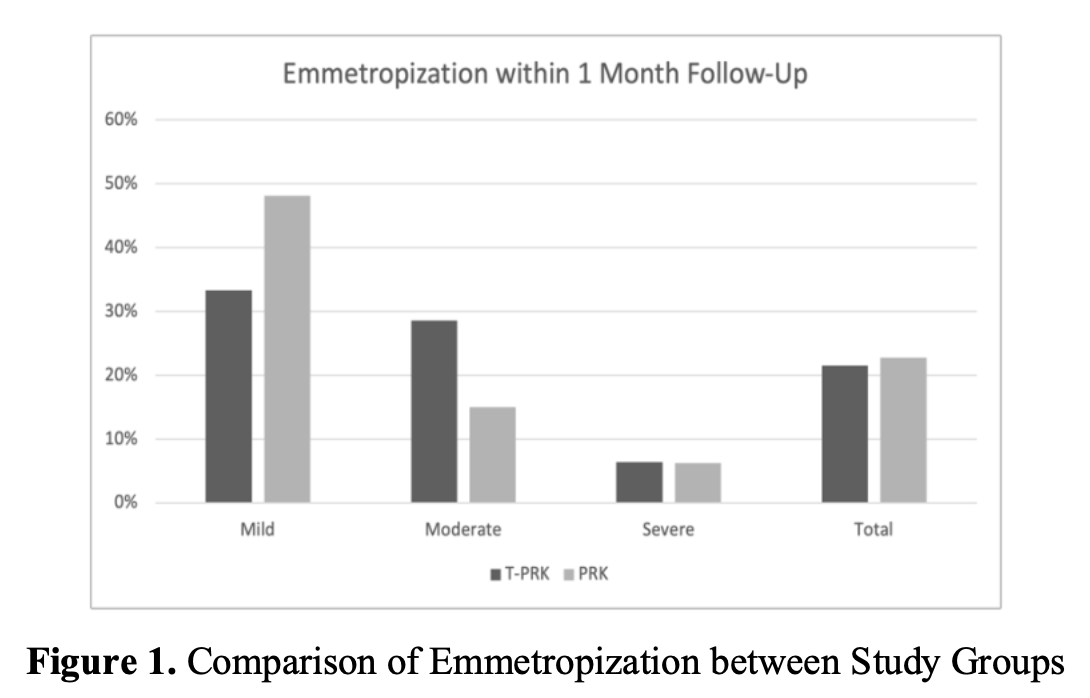The Comparison of Transepithelial versus Conventional Photorefractive Keratectomy
Trans vs conventional PRK
DOI:
https://doi.org/10.35749/journal.v48i1.100230Keywords:
Photorefractive keratectomy, transepithelial, subepithelial, myopiaAbstract
Introduction : Photorefractive keratectomy (PRK) is the first choice in treating myopia for eyes with mildly irregular and/or thin corneas because it preserves corneal integrity. A laser-assisted method for epithelial removal, termed Transepithelial PRK (T-PRK), was introduced as an alternative to conventional PRK, which gives a smoother corneal surface than that achieved with mechanical ablation of the epithelium in conventional PRK.
Objective: To compare emmetropization between patients treated with T-PRK and conventional PRK.
Methods: This study was an observative comparative analytic study with case-control study design. Myopic eyes treated by T-PRK (study group) were compared with variable-adjusted eyes treated by conventional PRK (control group), from year 2015-2018 at Dr.YAP Eye Hospital Yogyakarta. Patients were divided into 3 groups based on the degree on myopia; mild (spherical minus 0-3D), moderate (4-6D), and severe (>7D). Emmetropization within 1 month follow-up and treatment time were analyzed.
Results: In all of the cases reviewed, the total percentage of patients treated with T-PRK who reached emmetropization within 1 month follow-up was 21.51% (17/79 eyes), with 33.34% (9/27 eyes) in mild, 28.57% (6/21 eyes) in moderate, and 6.45% (2/31 eyes) in severe myopia group; compared to the control group which was 22.78% (18/79 eyes) (p=0.848), with 48.14% (13/27 eyes) in mild, 15% (3/20 eyes) in moderate, and 6.25% (2/32 eyes) in severe myopia group. Treatment time in the study group was relatively faster compared to the control group.
Conclusions: The study group showed slightly better result in treating moderate myopia within 1 month follow-up. Treatment time was relatively faster compared to the control group.
Downloads
References
Library of Suhardjo, Nugroho A, Widiastuti S, “Emmetrop-Achievement Time after Keratectomy for School-Proposing Candidate with Low and Moderate Myopia at Dr. Yap Eye Hospital Yogyakarta”, unpublished.
Fadlallah A, Fahed D, Khalil K, Dunia I, Menassa J, El Rami H, Chlela E, Fahed S. Transepithelial photorefractive keratectomy: clinical results. Journal of Cataract & Refractive Surgery. 2011 Oct 1;37(10):1852-7.
Clinch TE, Moshirfar M, Weis JR, Ahn CS, Hutchinson CB, Jeffrey JH. Comparison of mechanical and transepithelial debridement during photorefractive keratectomy. Ophthalmology. 1999 Mar 1;106(3):483-9.
Kleves J. Prevalence of Refractive Errors in the Total Population and the Analysis of Myopic Progression in Adults Aged 20 to 39 in the Urban Area of Tirana, Albania. Open Journal of Ophthalmology. 2021 Sep 14;11(4):293-312.
Clinch TE, Moshirfar M, Weis JR, Ahn CS, Hutchinson CB, Jeffrey JH. Comparison of mechanical and transepithelial debridement during photorefractive keratectomy. Ophthalmology. 1999 Mar 1;106(3):483-9.
Pedrotti E, Sbabo A, Marchini G. Customized transepithelial photorefractive keratectomy for iatrogenic ametropia after penetrating or deep lamellar keratoplasty. Journal of Cataract & Refractive Surgery. 2006 Aug 1;32(8):1288-91.
Jain VK, Abell TG, Bond WI, Stevens G Jr. Immediate transepithelial photorefractive keratectomy for treatment of laser in situ keratomileusis flap complications. Journal of Refractive Surgery. 2002; 18:109–112.
Naderi M, Jadidi K, Mosavi SA, Daneshi SA. Transepithelial photorefractive keratectomy for low to moderate myopia in comparison with conventional photorefractive keratectomy. Journal of ophthalmic & vision research. 2016 Oct;11(4):358.
Adib-Moghaddam S, Soleyman-Jahi S, Salmanian B, Omidvari AH, Adili-Aghdam F, Noorizadeh F, Eslani M. Single-step transepithelial photorefractive keratectomy in myopia and astigmatism: 18-month follow-up. Journal of Cataract & Refractive Surgery. 2016 Nov 1;42(11):1570-8.
Møller-Pedersen T, Cavanagh HD, Petroll WM, Jester JV. Corneal haze development after PRK is regulated by volume of stromal tissue removal. Cornea. 1998 Nov 1;17(6):627.
Angunawela RI, Winkler von Mohrenfels C, Kumar A, O’Brart DP, Marshall J. Live or let die: epithelial flap vitality and keratocyte proliferation following LASEK and epi-LASIK in human donor and porcine eyes. Journal of Refractive Surgery. 2011 Feb 1;27(2):111-8.
Ghoreishi M, Attarzadeh H, Tavakoli M, Moini HA, Zandi A, Masjedi A, Rismanchian A. Alcohol-assisted versus mechanical epithelium removal in photorefractive keratectomy. Journal of ophthalmic & vision research. 2010 Oct;5(4):223.
Gharieb HM, Mo’mena Ahmad A, Ahmed AA, Othman IS. Transepithelial Laser versus Alcohol Assisted Photorefractive Keratectomy Safety and Efficacy: 1-Year Follow-up of a Contralateral Eye Study. Korean Journal of Ophthalmology: KJO. 2021 Apr;35(2):142.
Luger MH, Ewering T, Arba-Mosquera S. Consecutive myopia correction with transepithelial versus alcohol-assisted photorefractive keratectomy in contralateral eyes: one-year results. Journal of Cataract & Refractive Surgery. 2012 Aug 1;38(8):1414-23.
Pertiwi AN, Mahayana IT, Supartoto A, Goenawan W. Transepithelial photorefractive keratectomy for myopia: effect of age and keratometric values. International Journal of Ophthalmology. 2021;14(5):744.

Downloads
Published
Issue
Section
Categories
License
Copyright (c) 2022 Puspita Salfasari, Suhardjo, Indra Tri Mahayana

This work is licensed under a Creative Commons Attribution-NonCommercial-ShareAlike 4.0 International License.
